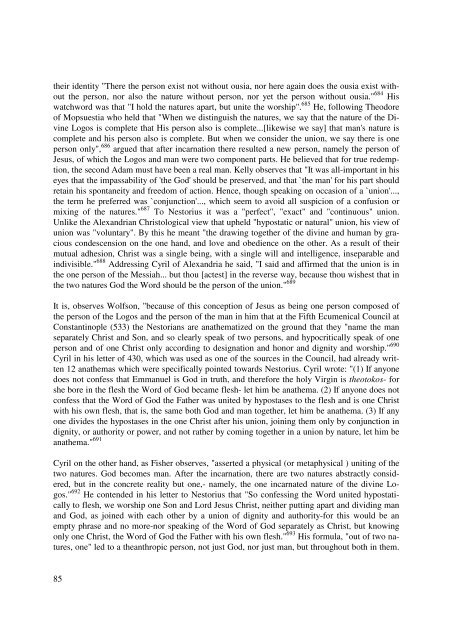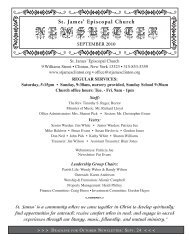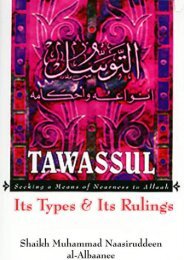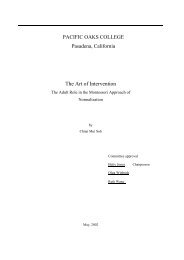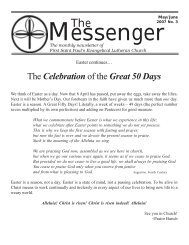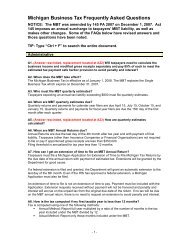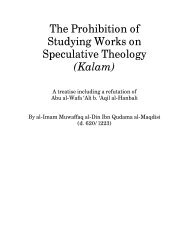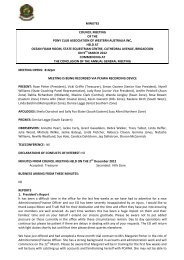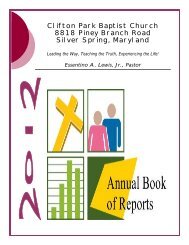Scripture and God in Christianity
Scripture and God in Christianity
Scripture and God in Christianity
Create successful ePaper yourself
Turn your PDF publications into a flip-book with our unique Google optimized e-Paper software.
their identity "There the person exist not without ousia, nor here aga<strong>in</strong> does the ousia exist without<br />
the person, nor also the nature without person, nor yet the person without ousia." 684 His<br />
watchword was that "I hold the natures apart, but unite the worship". 685 He, follow<strong>in</strong>g Theodore<br />
of Mopsuestia who held that "When we dist<strong>in</strong>guish the natures, we say that the nature of the Div<strong>in</strong>e<br />
Logos is complete that His person also is complete...[likewise we say] that man's nature is<br />
complete <strong>and</strong> his person also is complete. But when we consider the union, we say there is one<br />
person only", 686 argued that after <strong>in</strong>carnation there resulted a new person, namely the person of<br />
Jesus, of which the Logos <strong>and</strong> man were two component parts. He believed that for true redemption,<br />
the second Adam must have been a real man. Kelly observes that "It was all-important <strong>in</strong> his<br />
eyes that the impassability of 'the <strong>God</strong>' should be preserved, <strong>and</strong> that `the man' for his part should<br />
reta<strong>in</strong> his spontaneity <strong>and</strong> freedom of action. Hence, though speak<strong>in</strong>g on occasion of a `union'...,<br />
the term he preferred was `conjunction'..., which seem to avoid all suspicion of a confusion or<br />
mix<strong>in</strong>g of the natures." 687 To Nestorius it was a "perfect", "exact" <strong>and</strong> "cont<strong>in</strong>uous" union.<br />
Unlike the Alex<strong>and</strong>rian Christological view that upheld "hypostatic or natural" union, his view of<br />
union was "voluntary". By this he meant "the draw<strong>in</strong>g together of the div<strong>in</strong>e <strong>and</strong> human by gracious<br />
condescension on the one h<strong>and</strong>, <strong>and</strong> love <strong>and</strong> obedience on the other. As a result of their<br />
mutual adhesion, Christ was a s<strong>in</strong>gle be<strong>in</strong>g, with a s<strong>in</strong>gle will <strong>and</strong> <strong>in</strong>telligence, <strong>in</strong>separable <strong>and</strong><br />
<strong>in</strong>divisible." 688 Address<strong>in</strong>g Cyril of Alex<strong>and</strong>ria he said, "I said <strong>and</strong> affirmed that the union is <strong>in</strong><br />
the one person of the Messiah... but thou [actest] <strong>in</strong> the reverse way, because thou wishest that <strong>in</strong><br />
the two natures <strong>God</strong> the Word should be the person of the union." 689<br />
It is, observes Wolfson, "because of this conception of Jesus as be<strong>in</strong>g one person composed of<br />
the person of the Logos <strong>and</strong> the person of the man <strong>in</strong> him that at the Fifth Ecumenical Council at<br />
Constant<strong>in</strong>ople (533) the Nestorians are anathematized on the ground that they "name the man<br />
separately Christ <strong>and</strong> Son, <strong>and</strong> so clearly speak of two persons, <strong>and</strong> hypocritically speak of one<br />
person <strong>and</strong> of one Christ only accord<strong>in</strong>g to designation <strong>and</strong> honor <strong>and</strong> dignity <strong>and</strong> worship." 690<br />
Cyril <strong>in</strong> his letter of 430, which was used as one of the sources <strong>in</strong> the Council, had already written<br />
12 anathemas which were specifically po<strong>in</strong>ted towards Nestorius. Cyril wrote: "(1) If anyone<br />
does not confess that Emmanuel is <strong>God</strong> <strong>in</strong> truth, <strong>and</strong> therefore the holy Virg<strong>in</strong> is theotokos- for<br />
she bore <strong>in</strong> the flesh the Word of <strong>God</strong> became flesh- let him be anathema. (2) If anyone does not<br />
confess that the Word of <strong>God</strong> the Father was united by hypostases to the flesh <strong>and</strong> is one Christ<br />
with his own flesh, that is, the same both <strong>God</strong> <strong>and</strong> man together, let him be anathema. (3) If any<br />
one divides the hypostases <strong>in</strong> the one Christ after his union, jo<strong>in</strong><strong>in</strong>g them only by conjunction <strong>in</strong><br />
dignity, or authority or power, <strong>and</strong> not rather by com<strong>in</strong>g together <strong>in</strong> a union by nature, let him be<br />
anathema." 691<br />
Cyril on the other h<strong>and</strong>, as Fisher observes, "asserted a physical (or metaphysical ) unit<strong>in</strong>g of the<br />
two natures. <strong>God</strong> becomes man. After the <strong>in</strong>carnation, there are two natures abstractly considered,<br />
but <strong>in</strong> the concrete reality but one,- namely, the one <strong>in</strong>carnated nature of the div<strong>in</strong>e Logos."<br />
692 He contended <strong>in</strong> his letter to Nestorius that "So confess<strong>in</strong>g the Word united hypostatically<br />
to flesh, we worship one Son <strong>and</strong> Lord Jesus Christ, neither putt<strong>in</strong>g apart <strong>and</strong> divid<strong>in</strong>g man<br />
<strong>and</strong> <strong>God</strong>, as jo<strong>in</strong>ed with each other by a union of dignity <strong>and</strong> authority-for this would be an<br />
empty phrase <strong>and</strong> no more-nor speak<strong>in</strong>g of the Word of <strong>God</strong> separately as Christ, but know<strong>in</strong>g<br />
only one Christ, the Word of <strong>God</strong> the Father with his own flesh." 693 His formula, "out of two natures,<br />
one" led to a theanthropic person, not just <strong>God</strong>, nor just man, but throughout both <strong>in</strong> them.<br />
85


